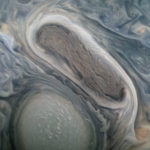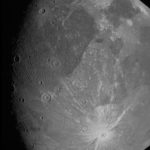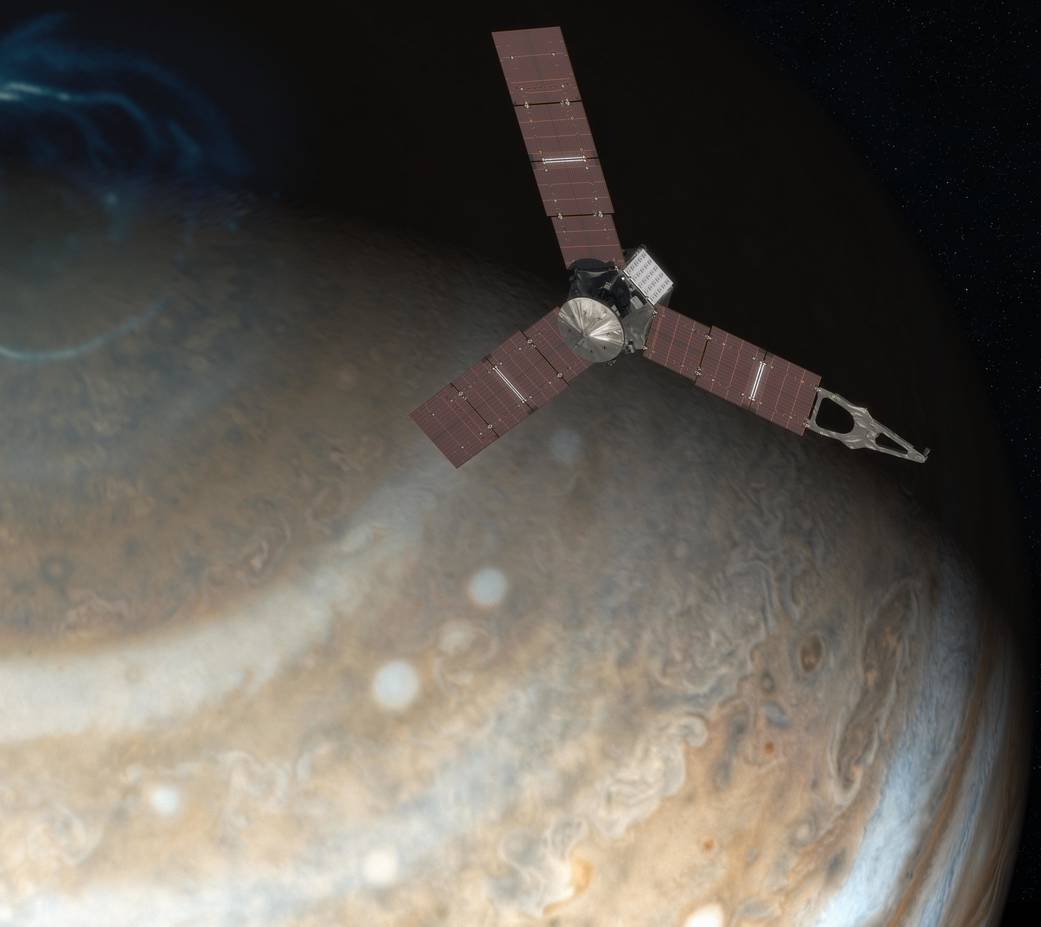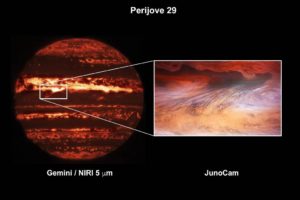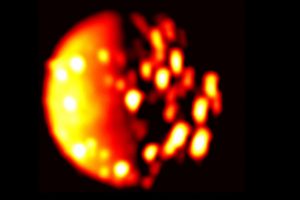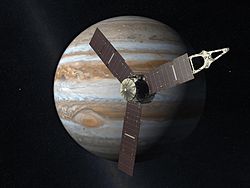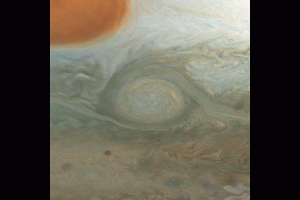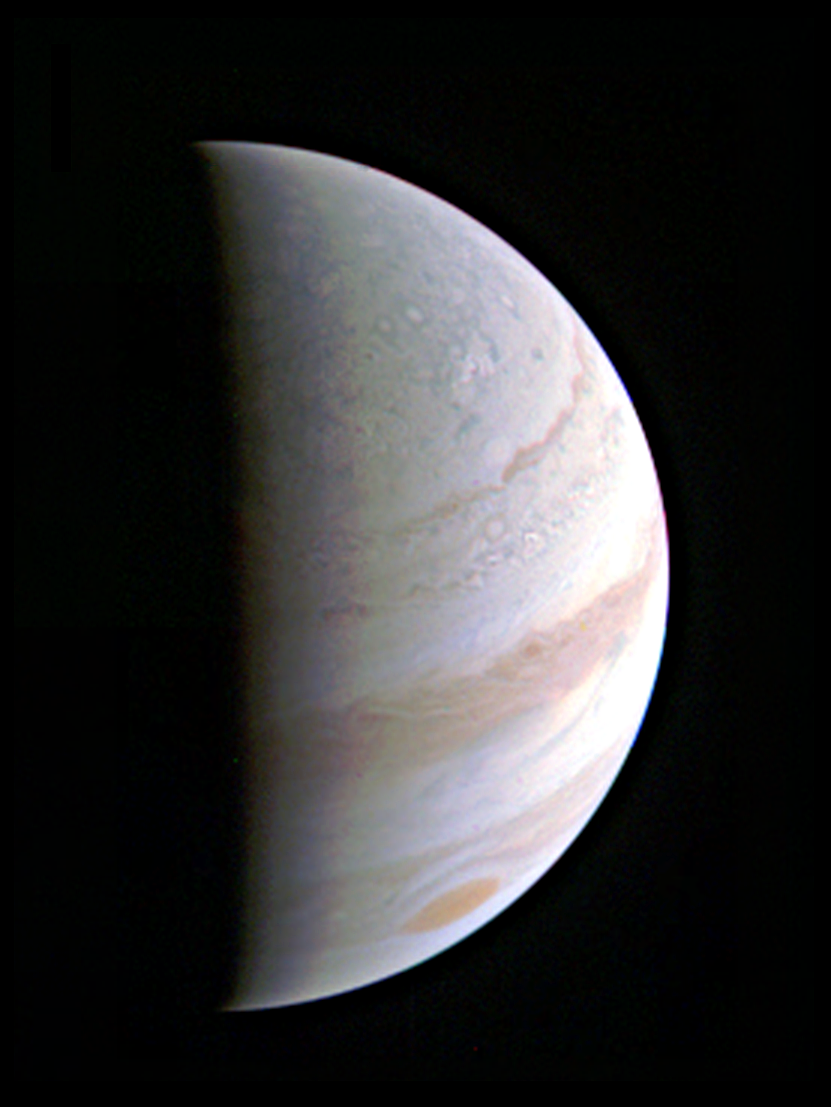This JunoCam image shows two of Jupiter’s large rotating storms, captured on Juno’s 38th perijove pass, on Nov. 29, 2021.
Credits: NASA/JPL-Caltech/SwRI/MSSS Image processing: Kevin M. Gill CC BY
NASAの新しい公開記事で、木星大気における複雑な渦の様子と、地球の海洋観測で見られる渦との類似性に言及しています。
ただし、肝心のその具体的な中身(メカニズム)についての説明はありません。
ノルウェー海の渦(海面にプランクトンが漂流しているようです)と、木星の極の渦の画像を並べて掲載しています。(確かに似ていますネ)
Two of Jupiter’s large rotating storms
Earth’s Oceans, Jupiter’s Atmosphere

Left to right: A phytoplankton bloom in the Norwegian Sea, and turbulent clouds in Jupiter’s atmosphere. Jupiter images provided by NASA’s Juno spacecraft have given oceanographers the raw materials to study the rich turbulence at the gas giant’s poles and the physical forces that drive large cyclones on Jupiter.
左から右:ノルウェー海に植物プランクトンが渦をまき、木星の大気に乱流の雲があります。 NASAのジュノー探査機によってもたらされた木星の画像は、海洋学者に、ガス惑星の極での豊富な乱気流と木星で大きなサイクロンを駆動する物理的な力を研究するための原材料を提供しました。
Credits: NASA OBPG OB.DAAC/GSFC/Aqua/MODIS Image processing: Gerald Eichstadt CC BY
Lia Siegelman, a physical oceanographer and postdoctoral fellow at Scripps Institution of Oceanography at the University of California, San Diego, decided to study the dynamics of Jupiter’s atmosphere after noticing that the cyclones at Jupiter’s pole appear to share similarities with ocean vortices she studied during her time as a doctoral student.
カリフォルニア大学サンディエゴ校のスクリップス海洋研究所の物理海洋学者兼博士研究員である来ア・シーゲルマンは、木星の極のサイクロンが研究していた地球の海洋渦と類似しているように見えることに気づいた後、博士課程の学生としての時間で、木星の大気のダイナミクスを研究することにしました。
“When I saw the richness of the turbulence around the Jovian cyclones, with all the filaments and smaller eddies, it reminded me of the turbulence you see in the ocean around eddies,” said Siegelman. “These are especially evident in high-resolution satellite images of vortices in Earth’s oceans that are revealed by plankton blooms that act as tracers of the flow.”
「フィラメントと小さな乱気流を伴う木星サイクロンの周りの乱気流の豊かさを見たとき、それは地球の海における渦の周りの乱気流を思い出させました」とシーゲルマンは言いました。 「これらは、流れの可視化する作用になるプランクトンの異常発生によって明らかになり、地球の海洋の渦の高解像度衛星画像で特にはっきり見ることができます。」
The simplified model of Jupiter’s pole shows that geometric patterns of vortices, like those observed on Jupiter, spontaneously emerge, and survive forever. This means that the basic geometrical configuration of the planet allows these intriguing structures to form.
木星の極を簡略化したモデルは、木星で観察されたような渦の幾何学的パターンが自発的に出現し、永遠に存続することを示しています。これは、惑星の基本的な地理構成により、これらの興味深い構造を形成できることを意味します。
Although Jupiter’s energy system is on a scale much larger than Earth’s, understanding the dynamics of the Jovian atmosphere could help us understand the physical mechanisms at play on our own planet.
木星のエネルギーシステムは地球よりもはるかに大規模ですが、木星の大気のダイナミクスを理解することは、私たち自身の地球で働いている物理的メカニズムを理解するのに役立つ可能性があります。
More About the Mission
JPL, a division of Caltech in Pasadena, California, manages the Juno mission for the principal investigator, Scott J. Bolton, of the Southwest Research Institute in San Antonio. Juno is part of NASA’s New Frontiers Program, which is managed at NASA’s Marshall Space Flight Center in Huntsville, Alabama, for the agency’s Science Mission Directorate in Washington. Lockheed Martin Space in Denver built and operates the spacecraft.
Follow the mission on Facebook and Twitter, and get more information about Juno online at:
https://www.nasa.gov/juno
DC Agle
Jet Propulsion Laboratory, Pasadena, Calif.
818-393-9011
agle@jpl.nasa.gov
Karen Fox / Alana Johnson
NASA Headquarters, Washington
301-286-6284 / 202-358-1501
karen.c.fox@nasa.gov / alana.r.johnson@nasa.gov
Deb Schmid
Southwest Research Institute, San Antonio
210-522-2254
dschmid@swri.org
2021-245Last Updated: Dec 22, 2021Editor: Tony Greicius

